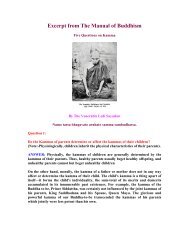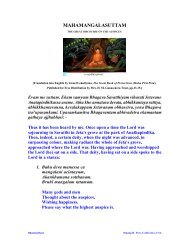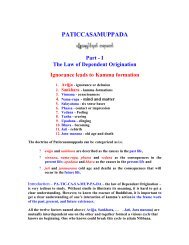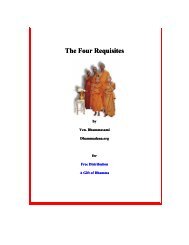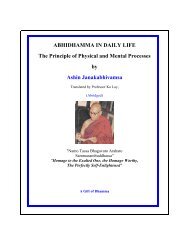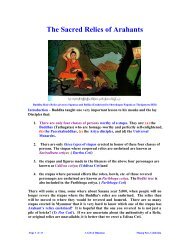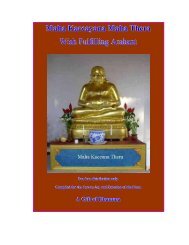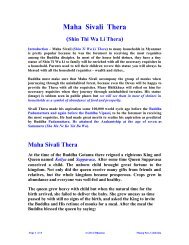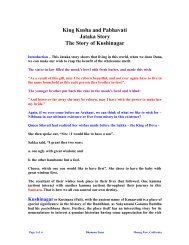AVALOKITESVARA Loka Nat Worship in Myanmar
AVALOKITESVARA Loka Nat Worship in Myanmar
AVALOKITESVARA Loka Nat Worship in Myanmar
Create successful ePaper yourself
Turn your PDF publications into a flip-book with our unique Google optimized e-Paper software.
hears/looks <strong>in</strong> every direction” and “the lord of hear<strong>in</strong>g the deepest”. The<br />
great vow of Avalokitesvara is to listen to the supplications from those <strong>in</strong><br />
difficulty <strong>in</strong> the world and to delay his own Buddhahood until he has helped<br />
every be<strong>in</strong>g on earth achiev<strong>in</strong>g enlightenment. Therefore, he is treated as the<br />
embodiment of all the Buddha’s' compassion, the lord of <strong>in</strong>f<strong>in</strong>ite compassion<br />
<strong>in</strong> Mahayana Buddhism.<br />
Avalokitesvara is also an emanation of Amitabha’s compassion and with<br />
Amitabha’s figure represented <strong>in</strong> his headdress. He guards the world <strong>in</strong> the<br />
<strong>in</strong>terval between the departure of the historical Buddha, Sakyamuni, and the<br />
appearance of the future Buddha, Mettreyya. Based on scriptures of the Pure<br />
Land school that were translated <strong>in</strong>to Ch<strong>in</strong>ese between the 3rd and 5th<br />
centuries, the Pure Land sect practitioner look to rebirth <strong>in</strong> the Western<br />
Paradise of the Buddha Amitabha, Avalokitesvara forms part of a rul<strong>in</strong>g<br />
triad, along with Amitabha and the bodhisattva Mahasthamaprapta. Images<br />
of the three are often placed together <strong>in</strong> temples.<br />
Accord<strong>in</strong>g to the Ch<strong>in</strong>ese Tantric (Mi-tsung) school from Tang Dynasty,<br />
Avalokitesvara’s ability to assume <strong>in</strong>numerable forms that has led to thirtythree<br />
major representations. The follow<strong>in</strong>g n<strong>in</strong>e representations are the most<br />
famous ones. Among them the first seven has later become the famous Seven<br />
Avalokitesvara <strong>in</strong> Japanese Tantric (Sh<strong>in</strong>gon) school:<br />
(1) Sahasrabhuja (Senju), the 1,000 armed figure;<br />
(2) Ekadasamuhka (Ju-ichi-men), the 11 faced with 2-or 4-handed<br />
figure;<br />
(3) C<strong>in</strong>tamani cakra (Nyo-i-r<strong>in</strong>), the seated figure, with 6 arms, hold<strong>in</strong>g<br />
the wish-fulfill<strong>in</strong>g jewel.<br />
(4) Amoghapasa (Fuku-kenjaku), the one with lasso and net, a form<br />
popular with the Tendai sect;<br />
(5) Hayagriva (Ba-to), the one with a fierce face and a horse's head <strong>in</strong><br />
the hairdress;<br />
(6) Cundi (Jun-tei), the seated figure with 18 arms, the mother<br />
goddess;<br />
(7) Aryavalokitesvara (Sho), the sacred, simple form;<br />
(8) Palasambari (Ye-I), the one with leaf clothes, with 2 or 4 arms;<br />
Page 8 of 12 A Gift of Dhamma Maung Paw, California




